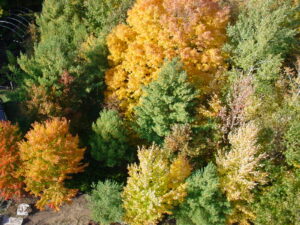Solar panels, wind generators, electric cars and other human created technology receive a lot of attention in the media as a way to meet our daily needs while reducing our impact on the environment. At the same time our natural environment is silently doing the heavy lifting by providing the infrastructure that secures all life and it even automatically replicates itself to do more. You can take advantage of the natural process of regeneration when you grow plants on your property that will protect your investment, promote well-being, create a resilient environment and reduce your energy footprint.
Trees, shrubs, grasses, forbs, perennials, annuals, microscopic plants and yes, even weeds are elegantly designed to care for us and the planet. While most people know that plants are ultimately responsible for all of the food we eat, provide significant components in the homes we live in and reside in many of the clothes we wear; they are doing much more:
- Keep Water Out Of Your Basement: Human activities often remove many trees that are replaced

Trees are hard at work intercepting and slowing precipitation, providing shade, creating habitat for wildlife and they look good doing it!
with compacted and impervious surfaces that don’t permit water infiltration. A deciduous tree can intercept up to 1000 gallons of precipitation a year and an evergreen can intercept up to 4000 gallons in the same time and allow it to directly evaporate. Tree root systems, dropped needles and leaves and other organic materials on the ground aerate the soil allowing absorption of rain and melting snow. All of this slows the movement of water, reducing flooding.
- Purchase Less Fertilizer: While the above-ground portion of plants catches and slows the erosion energy of pelting rain, the below ground root systems hold soil and its accompanying nutrients in place. The run-off of soil and nutrients to lakes and waterways causes algae and weed growth, pollution and increases invasive species. A complete ground-cover of plants will continuously cycle and recycle nutrients so that they are available for you. Some plants even produce their own fertilizer by a process called nitrogen fixation!
- Minimize the Utility Bill: Plants surrounding your home can cool it through the process of evapotranspiration, a natural process in which water is moved through plants and evaporated into the atmosphere. Deciduous trees can shade your home during the summer and evergreen trees provide energy saving wind breaks during winter. Did you know that home air conditioners can use the equivalent electricity of thirty 100 watt light bulbs and account for about 6% of the electricity used in the U.S.? Do you want to replace that with a few trees?
- Better Bird Feed: Consumers in the U.S. annually spend about $6.3 billion on birdseed (up to 1.2 million tons) and feeders. There are concerns that artificial feeding of birds is hurting them and the environment. And how do you successfully grow birdseed without displacing birds anyway? You can grow a variety of plants for nutritious food and life giving habitat that birds will use year round, bringing the birds close for you to see.
High-tech equipment, tools and vehicles certainly have a place in improving where we live. However by growing and nurturing plants we efficiently achieve a range of benefits for ourselves, attain multiple dividends for each action we take with plants, produce an overflow of benefits for the community and create abundance for the planet. Are you ready for the amazing power of plants to make your world a better place?
